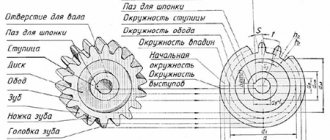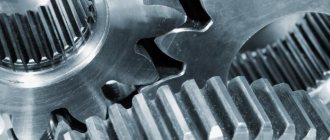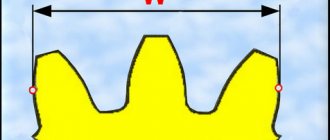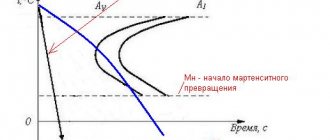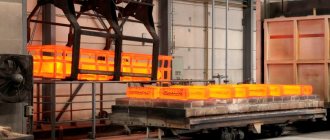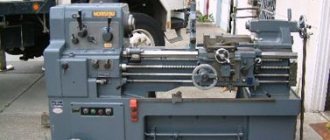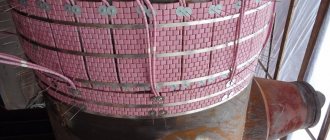For the first time, V.P. proposed hardening of parts using induction heating. Volodin. This happened almost a century ago - in 1923. And in 1935, this type of heat treatment began to be used for hardening steel. The popularity of hardening today is difficult to overestimate - it is actively used in almost all branches of mechanical engineering, and HDTV installations for hardening are also in great demand.
To increase the hardness of the hardened layer and increase the toughness in the center of the steel part, it is necessary to use surface high-frequency hardening. In this case, the top layer of the part is heated to the hardening temperature and sharply cooled. It is important that the properties of the core of the part remain unchanged. Since the center of the part retains its toughness, the part itself becomes stronger.
With the help of high-frequency hardening it is possible to strengthen the inner layer of an alloyed part; it is used for medium-carbon steels (0.4-0.45% C).
High frequency hardening technology
HDTV surface hardening is a heat treatment process to increase the strength characteristics and hardness of the workpiece.
The main stages of surface hardening of HDTV are induction heating to a high temperature, holding at it, then rapid cooling. Heating during hardening of HDTV is carried out using a special induction installation. Cooling is carried out in a bath with a coolant (water, oil or emulsion) or by spraying it onto the part from special shower installations.
Temperature selection
For the correct completion of the hardening process, the correct selection of temperature, which depends on the material used, is very important.
Steels based on carbon content are divided into hypoeutectoid - less than 0.8% and hypereutectoid - more than 0.8%. Steel with carbon less than 0.4% is not hardened due to the resulting low hardness. Hypoeutectoid steels are heated slightly above the temperature of the phase transformation of pearlite and ferrite to austenite. This occurs in the range of 800-850°C. Then the workpiece is quickly cooled. When cooled sharply, austenite transforms into martensite, which has high hardness and strength. A short holding time makes it possible to obtain fine-grained austenite and fine-needle martensite; the grains do not have time to grow and remain small. This steel structure has high hardness and at the same time low brittleness.
Microstructure of steel
Hypereutectoid steels are heated slightly lower than hypoeutectoid steels, to a temperature of 750-800°C, that is, incomplete hardening is performed. This is due to the fact that when heated to this temperature, in addition to the formation of austenite, a small amount of cementite, which has a higher hardness than martensite, remains undissolved in the metal melt. After rapid cooling, austenite transforms into martensite, and cementite remains in the form of small inclusions. Also in this zone, carbon that has not had time to completely dissolve forms solid carbides.
In the transition zone during high-frequency quenching, the temperature is close to the transition temperature, and austenite with ferrite residues is formed. But, since the transition zone does not cool down as quickly as the surface, but cools down slowly, as during normalization. At the same time, the structure in this zone improves, it becomes fine-grained and uniform.
Overheating the surface of the workpiece promotes the growth of austenite crystals, which has a detrimental effect on brittleness. Underheating prevents the complete ferrite-perrite structure from transforming into austenite, and unhardened spots may form.
After cooling, high compressive stresses remain on the metal surface, which increase the performance properties of the part. Internal stresses between the surface layer and the middle must be eliminated. This is done using low-temperature tempering - holding at a temperature of about 200°C in an oven. To avoid the appearance of microcracks on the surface, it is necessary to minimize the time between hardening and tempering.
You can also carry out the so-called self-tempering - cool the part not completely, but to a temperature of 200 ° C, while heat will remain in its core. Then the part should cool slowly. This will equalize internal stresses.
Main characteristics
Steel 40X13, sometimes referred to as 4X13, is classified as a corrosion-resistant, heat-resistant grade. The domestic substitute is steel 30X13. The chemical composition of this material includes:
This composition allows the following products to be manufactured from this steel:
- cutting and measuring tools;
- medical, including surgical instruments;
- structural elements operating in mildly aggressive environments.
- springs, fasteners, shafts and bearings capable of operating in aggressive environments, including temperatures up to 450 ºC.
Induction installation
The HDTV induction heat treatment unit is a high-frequency generator and inductor for HDTV hardening. The part to be hardened can be located in or near the inductor. The inductor is made in the form of a coil, with a copper tube wound on it. It can have any shape depending on the shape and size of the part. When alternating current passes through the inductor, an alternating electromagnetic field appears in it, passing through the part. This electromagnetic field causes eddy currents known as Foucault currents to occur in the workpiece. Such eddy currents, passing through layers of metal, heat it to a high temperature.
HDTV induction heater
A distinctive feature of induction heating using HDTV is the passage of eddy currents on the surface of the heated part. This way, only the outer layer of the metal is heated, and the higher the frequency of the current, the smaller the depth of heating, and, accordingly, the depth of hardening of the high-frequency frequency. This makes it possible to harden only the surface of the workpiece, leaving the inner layer soft and tough to avoid excessive brittleness. Moreover, you can adjust the depth of the hardened layer by changing the current parameters.
The increased frequency of the current allows you to concentrate a large amount of heat in a small area, which increases the heating rate to several hundred degrees per second. Such a high heating rate moves the phase transition to a higher temperature zone. In this case, the hardness increases by 2-4 units, to 58-62 HRC, which cannot be achieved with volumetric hardening.
For the correct implementation of the HDTV hardening process, it is necessary to ensure that the same clearance is maintained between the inductor and the workpiece over the entire hardening surface, and mutual touching must be avoided. This is ensured, if possible, by rotating the workpiece in the centers, which allows for uniform heating, and, as a consequence, the same structure and hardness of the surface of the hardened workpiece.
The inductor for hardening HDTV has several versions:
- single- or multi-turn annular - for heating the outer or inner surface of parts in the form of bodies of rotation - shafts, wheels or holes in them;
- loop - for heating the working plane of the product, for example, the surface of the bed or the working edge of the tool;
- shaped - for heating parts of complex or irregular shape, for example, the teeth of gear wheels.
Depending on the shape, size and depth of the hardening layer, the following HDTV hardening modes are used:
- simultaneous - the entire surface of the workpiece or a certain zone is heated at once, then also cooled simultaneously;
- continuous-sequential - one zone of a part is heated, then when the inductor or part is displaced, another zone is heated, while the previous one is cooled.
Simultaneous high-frequency heating of the entire surface requires large amounts of power, so it is more profitable to use it for hardening small parts - rolls, bushings, pins, as well as part elements - holes, necks, etc. After heating, the part is completely lowered into a tank with coolant or sprayed with a stream of water.
Continuous-sequential hardening of high-frequency particles allows you to harden large-sized parts, for example, the crowns of gear wheels, since during this process a small zone of the part is heated, which requires less power of the high-frequency generator.
Processing methods
The steel in question is subjected to two main types of processing: thermal and mechanical. Heat treatment of 40x13 steel is used to give it the appropriate technological properties. Mechanical - to create the required shape, solve the assigned technical problems.
Experts classify such metal into the category of materials that require a certain specific approach during heat treatment. It is this type of processing that gives the required properties.
Steel 40x13 in a hardening oven
The main types of heat treatment are:
- sequential hardening;
- slow release after heating;
- hot and cold plastic deformation;
- annealing.
After hardening, the following components are formed in the structure:
- carbides;
- martensites;
- some remains of so-called austenites.
Cooling parts
Cooling is the second important stage of the hardening process; the quality and hardness of the entire surface depends on its speed and uniformity. Cooling occurs in coolant tanks or by spray. For high-quality hardening, it is necessary to maintain a stable temperature of the coolant and prevent it from overheating. The holes in the sprayer must be of the same diameter and spaced evenly, this way the same metal structure on the surface is achieved.
To prevent the inductor from overheating during operation, water is constantly circulated through the copper tube. Some inductors are made combined with a workpiece cooling system. Holes are cut in the inductor tube through which cold water enters the hot part and cools it.
Hardening with high frequency currents
HDTV pipe and decoding
Dictionaries:
Dictionary of abbreviations and abbreviations of the army and special services. Comp. A. A. Shchelokov. - M.: AST Publishing House LLC, Geleos Publishing House CJSC, 2003. - 318 p., S. Fadeev. Dictionary of abbreviations of the modern Russian language. - St. Petersburg: Politekhnika, 1997. - 527 p.
high definition television
Dictionary:
S. Fadeev. Dictionary of abbreviations of the modern Russian language. - St. Petersburg: Politekhnika, 1997. - 527 p.
Dictionary of abbreviations and abbreviations. Academician 2015.
See what “HDTV” is in other dictionaries:
HDTV - HDTV: High-definition television High-frequency currents List of meanings of a word or phrase with links to relevant articles ... Wikipedia
HDTV - High frequency currents ... Metallurgical Dictionary
HDTV - high-definition television high-frequency current ... Dictionary of Russian language abbreviations
First HDTV - Closed Type ... Wikipedia
High Definition Television - This term has other meanings, see HD. High definition television, abbr. HDTV (English High Definition Television, abbreviated HDTV, HD), high-definition television is a type of television broadcast standards, ... ... Wikipedia
Satellite TV channels in Russia - Contents 1 Satellite and cable TV channels 1.1 General 1.2 Lifestyle and fashion ... Wikipedia
Krivosheev, Mark Iosifovich - Mark Iosifovich Krivosheev Date of birth: July 30, 1922 (1922 07 30) (90 years old) Place of birth: Poltava Country ... Wikipedia
Russian TV channels - List of Russian TV channels: See also the article Television in Russia Contents 1 All-Russian channels 1.1 Satellite and cable TV channels ... Wikipedia
high-definition television - HDTV Television with approximately twice the vertical and horizontal clarity compared to current standard systems and an enlarged frame format. [GOST 21879 88] high definition television HDTV Typically used in relation to... ... Technical Translator's Guide
Pervij TVCH — Senderlogo Allgemeine Informationen Empfang: Satellit, Kabel … Deutsch Wikipedia
Source
Advantages and disadvantages
Hardening of parts using HDTV has both advantages and disadvantages. The advantages include the following:
- After high-frequency quenching, the part retains a soft center, which significantly increases its resistance to plastic deformation.
- The cost-effectiveness of the process of hardening HDTV parts is due to the fact that only the surface or zone that needs to be hardened is heated, and not the entire part.
- During mass production of parts, it is necessary to set up the process and then it will be automatically repeated, ensuring the required quality of hardening.
- The ability to accurately calculate and adjust the depth of the hardened layer.
- The continuous-sequential hardening method allows the use of low-power equipment.
- A short heating and holding time at high temperature contributes to the absence of oxidation, decarburization of the top layer and the formation of scale on the surface of the part.
- Rapid heating and cooling does not result in large warpage and distortion, which allows for a reduction in finishing allowance.
But it is economically feasible to use induction installations only for mass production, and for single production, purchasing or manufacturing an inductor is unprofitable. For some parts with complex shapes, induction production is very difficult or impossible to obtain a uniform hardened layer. In such cases, other types of surface hardening are used, for example, gas-flame or volumetric hardening.
Steel 40Х13 corrosion-resistant
Substitute
Analogs
| Europe (EN) | 1.4031 |
| Germany (DIN) | X38Cr13, X39Cr13, 40Cr13, 46Cr13 |
| USA (AISI) | 420 |
| UK (BS) | 420S45 |
| Japan (JIS) | SUS420J2 |
| France (AFNOR NF) | Z40C13 |
| Sweden (SS) | 2304 |
Decoding
The number 40 indicates the average mass fraction of carbon in steel in hundredths of a percent, i.e. The average carbon content in steel 40Х13 is 0.40%.
The letter X indicates that the steel is alloyed with chromium (Cr), the number 13 after the letter indicates that the average mass fraction of chromium is 13%.
Type of delivery
- Long products, including shaped steel: GOST 5949-75, GOST 2590-88, GOST 2591-88, GOST 2879-88
- Calibrated rod GOST 8559-75, GOST 8560-78, GOST 7417-75.
- Strip GOST 4405-75, GOST 103-76.
- Wire 18143-72.
- Forgings and forged blanks GOST 1133-71.
Characteristics, properties and applications
Steel 40X13 is a chromium corrosion-resistant (stainless) steel of the martensitic class and is used for the manufacture of parts operating at temperatures up to 400-450°C, as well as parts operating in corrosive environments, for example:
- cutting tool,
- measuring tool,
- springs for operation up to 400-450°C;,
- carburetor needles,
- household items,
- compressor valve plates and other parts
Steel 40X13 is smelted in induction or arc furnaces. Steel is prone to hot cracking at high heating and cooling rates. When heated, the metal is placed in a furnace at a temperature of 500-540 °C, then, together with the furnace, it is slowly heated to 830 °C. After the temperature has been equalized across the cross-section, accelerated heating can be carried out;
The steel is deformed. The temperature of the beginning of hot deformation is 1100°C, the end temperature is 850°C. After deformation, slow cooling in the foot or sand is mandatory;
Temperature of critical points, °C
Chemical composition, % (GOST 5632-72)
Chemical composition, % (GOST 5632-2014)
| Brand number | Mass fraction of elements, % | |||||||
| Carbon | Silicon | Manganese | Chromium | Iron | Sulfur | Phosphorus | Corrosion-resistant | |
| No more | ||||||||
| 1-17 | 0,36-0,45 | No more than 0.80 | No more than 0.80 | 12,00-14,00 | Basic | 0,025 | 0,030 | + |
Heat treatment
Recommended heat treatment modes:
- I - annealing at 740-780 °C;
- II - hardening from 1030-1100°C in air or oil, tempering at 550-650°C;
- III - hardening from 1050-1100°C in oil, tempering at 200-300°C.
When carrying out heat treatment, the possibility of spontaneous cracking of the part during long-term aging should be taken into account, so tempering is carried out immediately after hardening.
Mechanical properties
| GOST | Delivery status | Section, mm | σв, MPa | δ5, % | Hardness |
| no less | |||||
| GOST 5949-75 | Rod. Quenching from 1000-1050 °C in oil; holiday at 200-300 °C, cool. in air or oil | Samples | — | — | Not less than HRCе 52 |
| GOST 18907-73 | Rod: ground, treated to specified strength, annealed | 1-30 St.5 | 590-810 — 550 | 10 15 | — HB 143-229 |
| GOST 5582-75 | Hot-rolled or cold-rolled sheet; annealing or tempering 740-800 °C (transverse samples) | Up to 3.9 | 550 | 15 | — |
| GOST 18143-72 | Heat treated wire | 1-6 | 590-880 | 10 | — |
Mechanical properties depending on tempering temperature
| ttp, °С | σ0.2, MPa | σв, MPa | δ5, % | ψ, % | KCU, J/cm2 | Hardness HRCе, НВ |
| 200 | 1620 | 1840 | 1 | 2 | 19 | 52 |
| 350 | 1450 | 1710 | 11 | 22 | 25 | 50 |
| 500 | 1390 | 1680 | 7 | 9 | 19 | 51 |
| 700 | 500 | 780 | 35 | 59 | 71 | HB 217 |
NOTE: hardening at 1000 °C in oil.
Mechanical properties at elevated temperatures
| tsp, °С | Delivery status | σ0.2, MPa | σв, MPa | δ5, % | ψ, % | KCU, J/cm2 |
| 20 410 470 510 | Hardening from 1030-1050°C in air; tempering at 530°C, holding for 2 hours, cooling. on air | 1420 1310 960 980 | 1670 1360 1130 1070 | 6 7 12 12 | 34 36 45 49 | 11 — 6 — |
| 20 200 300 400 500 600 | Hardening at 1050°C in air; tempering at 600 °C, holding for 3 hours. | 890 810 710 670 470 255 | 1120 940 900 780 520 300 | 13 11 10 12 20 21 | 32 40 39 45 77 84 | 12 49 69 73 78 118 |
| 20 400 450 500 | Hardening at 1050°C in air; tempering at 650 °C, holding for 3 hours. At 20°C HB 277-286 | 710 — 540 — | 930 — 640 540 | 14 — 15 18 | 42 — 44 67 | 24 93 — 132 |
| 800 900 950 1000 1050 1100 1150 1200 | Deformed sample with a diameter of 6 mm and a length of 30 mm; deformation speed 16 mm/min; strain rate 0.009 1/s | 120 43 34 27 | 130 53 40 32 | 64 68 84 70 73 60 64 60 | 96 92 96 98 100 98 100 100 | — — — — — — — — |
Mechanical properties at 20 °C depending on heat exposure
| Heat treatment | Heat exposure | σ0.2, MPa | σв, MPa | δ5, % | ψ, % | KCU, J/cm2 | |
| t, °С | τ, h | ||||||
| Hardening at 1050 °C in oil; vacation: | No heat soak | 940 | 1140 | 13 | 48 | 21 | |
| 550 °C, 10 hours. | 470 | 1000 3000 | 870 900 | 1080 1080 | 11 13 | 43 42 | — 23 |
| 600 °C, 3 hours. | No heat soak | 890 | 1120 | 13 | 32 | 11 | |
| 450 | 5000 10000 | 820 840 | 1080 1000 | 12 13 | 28-31 25-33 | — — | |
| 530 °C, 6 hours. | 470 | 500 1000 5000 | 930 880 750 | 1100 1060 990 | 13 14 14 | 47 46 37 | 15 — 22 |

